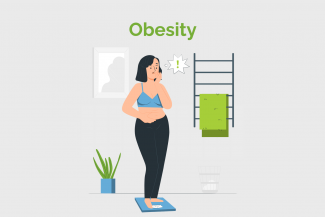Experts are beginning to consider there are different sorts of obesity beyond just the medical categories of overweight and obesity, which are based purely on body mass index (BMI). If correct, this may shed light on the discrepancy between the success rates of various strategies for losing weight.
The BMI formula is inaccurate and out of date. It does not account for individual differences in anatomy, culture, sexual orientation, or chronological age.
BMI is frequently utilised in the medical field despite its bias since it is a cheap and rapid approach to assess a patient’s health and prospective outcomes.
Difference Between Obesity and Overweight
A body mass index (BMI) between 25.0 and 29.9 is considered overweight. A patient is considered obese if their body mass index (BMI) is 30.0 or higher. (The normal range for body mass index is 18.5–24.9)
:max_bytes(150000):strip_icc():format(webp)/nice-chubby-young-woman-measuring-her-waist-1140647269-0d5be4d271064590b79a881069b6033d.jpg)
Morbid obesity is often defined as a body mass index (BMI) of 40 or higher. This threshold is recommended by national guidelines as a way to classify patients as possible candidates for bariatric surgery.
Although these variations are significant from a medical perspective, they ignore critical factors outside body mass index. However, many professionals are now looking elsewhere for guidance on identifying obesity and treating it.
Are There 59 Types of Obesity?
Genetics, eating habits, environmental factors, and inactivity all have a role in the development of obesity. While there appears to be some disagreement among obesity specialists as to how many distinct forms of obesity exist, they do seem to agree that there is more than one.
One can, for instance, maintain a healthy weight despite being overweight. Despite the increased risk of developing diabetes and heart disease associated with obesity, many overweight people report feeling well.
The Obesity, Metabolism, and Nutrition Institute director at Massachusetts General Hospital, Lee Kaplan, MD, PhD, told The New York Times in 2016 that he has identified 59 distinct forms of obesity.
Since more than 25 genes have been linked to obesity, it’s not unexpected that there are numerous subtypes of the disease. Several genes have been linked to obesity, most notably the FTO gene, although others may also contribute. The tendency to overeat in one sitting has been linked to specific genes.

At least six distinct forms of obesity were identified in a 2015 study published in the Journal of Public Health. Researchers analysed data from the Yorkshire Health Study that was conducted between 2010 and 2012.1
Their primary care physicians had mailed out survey forms to the study’s participants. A total of 27,806 persons were surveyed; 4,144 had a body mass index (BMI) of 30 or more, meeting the clinical criteria for obesity.
Age, sex, socioeconomic status, race/ethnicity, and health status were all topics included in the study. Overall health status and quality of life were measured. The participants’ smoking habits, levels of physical activity, and alcohol intake were also assessed.
Researchers used this data to categorise obese people into groups based on their shared traits beyond BMI. They did so and came to the conclusion that there was sufficient data to divide people with BMIs of 30 into six distinct categories:
Men who engage in “heavy drinking”
Young, robust women
Wealthy, robust retirees
Sick but content senior citizens
Negative, apprehensive, and middle-aged
Those in the worst physical condition
So, what did the researchers of this study find, in the end? There are several subsets of the obese population, and “it is important to account” for these variations “within individuals who are obese.” Since a “one-size-fits-all” strategy is unlikely to work, they went on to say that acknowledging these disparities can have substantial implications for clinical therapies and policy decisions meant to target and cure obesity.
Perhaps, for example, the primary reason for the emergence of obesity in the first category ofmen mentioned above is the existence of heavy drinking (of alcohol). If that’s the case, treating obesity should include cutting back on alcohol use.
The second group, young, healthy women, would not benefit from the same strategy because they are likely obese for various reasons. A new form of intervention would be required for them, and so on.
In addition, the second group, composed of young, healthy females, was the largest of the six. These ladies had good quality of life ratings and consumed less alcohol than the other groups.
Need for Different Approaches to Weight Loss
Knowing there are several forms of obesity should stimulate research into novel strategies for weight reduction.
If you’re overweight, you might have noticed this already: You probably already know that there are many ways to lose weight, and you may have even tried a number of them. Like most individuals, you probably tried one of these techniques after hearing positive results from a friend or doctor. But perhaps, despite your best efforts, you found that it didn’t work for you.
Now you can stop feeling bad about yourself for being overweight since you know that there are numerous types of obesity and what worked for one person could not work for you and it’s not your fault.
The vast majority of people, regardless of the type of obesity, can, in fact, lose weight, provided that they find the correct weight-loss technique that works for them. The important thing is to keep trying different things until you find what works for you.
There is a wide range of options for losing weight, from different diets to drugs to even bariatric surgery
Also Read: Explained: Why M&M acquired stake in RBL Bank
However, a nutritious diet is the foundation for all of these other changes, so don’t skip it. You may minimise your risk for chronic diseases like heart disease, diabetes, and cancer simply by adhering to some very basic rules of good eating, and this will be true regardless of how much weight you lose. So, it’s crucial to eat well.
Similarly, losing weight isn’t as important as engaging in regular physical activity; the benefits accrue over time in the form of a lower risk of cardiovascular disease, diabetes, cancer, and other chronic illnesses.
Remember that a good night’s sleep is essential to a wide range of health benefits, and make sure you prioritise it. Getting a good night’s rest on a regular basis can help you lose weight and keep it off, as well as improve your ability to handle stress. We now also know that getting enough sleep plays a crucial role in warding off cardiovascular disease.
Basically, it all comes down to prioritising your own health and wellbeing. Just focus on that and everything else will fall into place.






